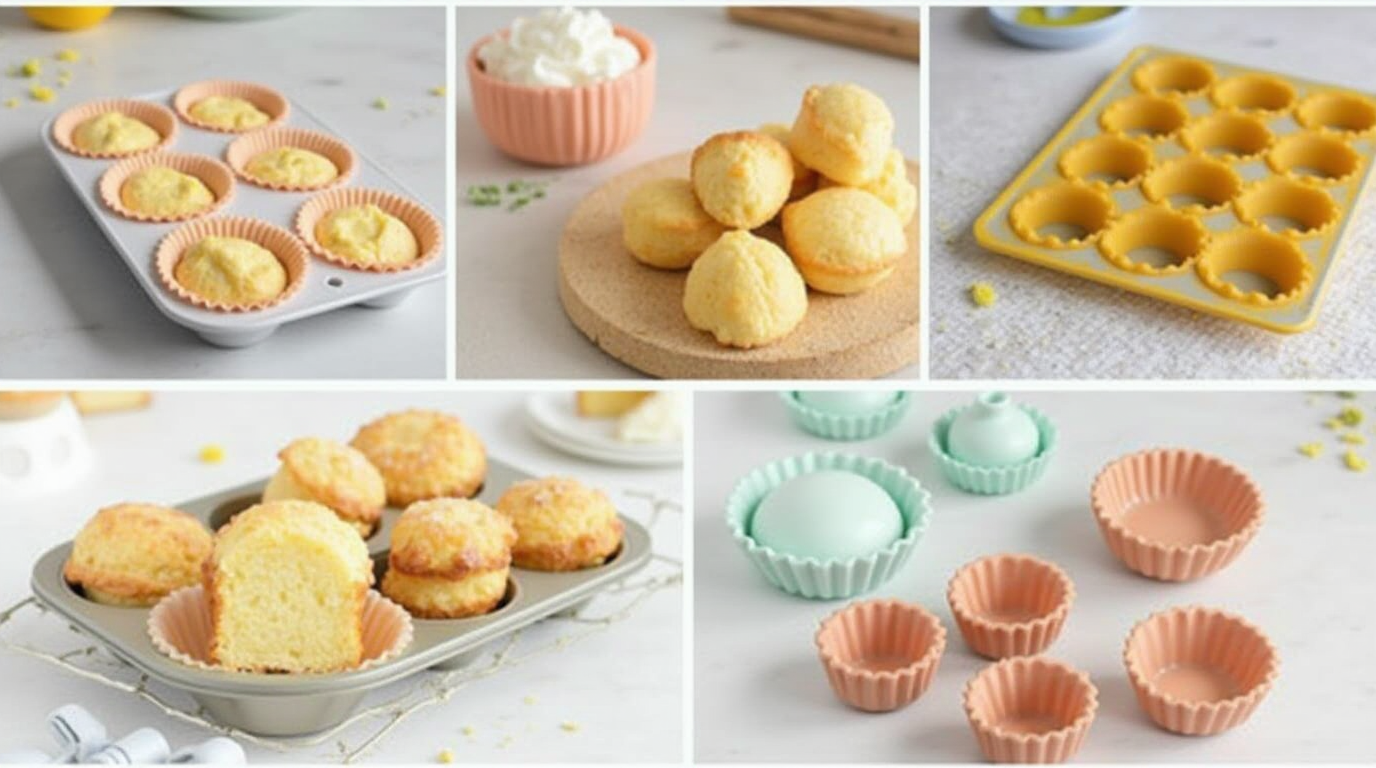If you’ve ever found yourself wondering what to do without Madeleine molds, you’re in luck! There are plenty of great substitute for Madeleine molds options that can help you make perfect madeleine-inspired cakes at home. Whether you’re using a muffin tin, silicone molds, or aluminum foil, there’s no need to worry. In this article, we’ll explore several substitute for Madeleine molds that will help you bake up a storm. So, if you’re out of Madeleine molds, let’s dive into the best alternatives to make your baking dreams come true!
Introduction to Madeleine Molds and Their Significance
Understanding Madeleine Molds
So, Madeleine molds—what are they exactly? Think of them as the secret sauce to those delicious, spongy little cakes that have the perfect mix of crispness on the edges and softness in the middle. These molds are typically made of metal or silicone and feature multiple shallow cavities in the shape of a shell (because why not make baking fun?). They’re a bit like the signature dish of French baking, often used for madeleines but also for other mini cakes and treats.
The Role of Molds in Baking
Now, let’s talk about why these molds matter. It’s not just about the cute shape (though, let’s face it, who doesn’t love that!). The shallow, curved form of the mold allows heat to distribute evenly, helping your Madeleine cakes cook up just right—crispy on the outside and soft inside. And while you can definitely make these cakes without a Madeleine mold, you might not get that perfect texture or shape we all love. But no worries—we’ve got some tricks up our sleeves!

Common Substitutes for Madeleine Molds
Muffin or Cupcake Tins
Okay, so maybe you don’t have a Madeleine mold sitting around—no big deal! One of the easiest alternatives is a regular muffin tin. I mean, it’s probably the most accessible option you’ve got in your kitchen, right? Sure, the shape won’t be the iconic shell we all love, but it still works. Just pour the batter into the muffin tin, and you’re all set. You might have to bake them a little longer, depending on how deep the cavities are. But in the end, the taste will still be spot-on!
Aluminum Foil Molds
If you’re looking to get a bit more creative, aluminum foil molds could be your best friend. They might sound a bit unconventional, but trust me—they do the job! You can actually mold aluminum foil into shell shapes that mimic the Madeleine pan. It’s a bit more work, but it’s definitely worth it if you’re after that perfect, traditional shape. Just shape the foil carefully, fill it with batter, and pop it in the oven. Voila! You’ll have your own homemade Madeleine molds ready to go.
Whoopie Pie Pans
Here’s a fun one: Whoopie pie pans. These pans have shallow, rounded cavities that can substitute for Madeleine molds quite nicely. They’re not quite as curved as the classic shell shape, but they’ll give you a similar texture and bake. You’ll still get that airy, soft center we love, and they’ll turn out looking cute. Just make sure to adjust the baking time slightly—whoopie pie pans are usually a bit bigger than Madeleine molds.

Considerations When Using Substitutes
Baking Time Adjustments
When you swap out your Madeleine molds, you’ll likely need to adjust your baking time. For example, using a muffin tin will probably require a bit longer in the oven since muffin tins have deeper cavities. On the flip side, aluminum foil molds might need less time to bake because they’re usually thinner and heat up faster. So, if you’re using a substitute for Madeleine molds, make sure you keep an eye on your cakes while they bake to avoid overcooking them.
Texture and Appearance Variations
Here’s the thing: when you’re not using the Madeleine mold, the shape might be different, and the texture could shift a little. The classic shell shape isn’t just for looks; it actually helps the batter cook evenly, creating that crisp outer edge. So, when you use something like a muffin tin or whoopie pie pan, the texture might end up a little different—slightly thicker or less crispy on the edges. But don’t worry! Your cakes will still taste great, and they’ll have that light, airy center we’re all after. It’s just a small trade-off for not using the original mold.
Step-by-Step Guide to Using Muffin Tins as Substitutes
Preparing the Batter
So, you’ve decided to use a muffin tin as a substitute for Madeleine molds—great choice! First, get your batter ready just as you would for traditional madeleines. Mix everything well, ensuring the batter is nice and smooth. Don’t forget to check for lumps—those little guys can ruin the texture! (Pro tip: You could use the Thermomix if you want to skip a few extra steps for smoother batter.) Once that’s done, set your batter aside for a moment.
Preparing the Muffin Tin
Here’s where the magic happens! Make sure your muffin tin is well-prepared. Grease each cavity generously or line them with paper liners if you’ve got them handy. I know, the grease might seem like a small detail, but trust me, you don’t want those little cakes sticking. Nobody likes a sticky situation! Now, it’s time to fill up the tin.
Filling the Molds
When it comes to filling the tin, don’t go overboard—aim for about two-thirds full. This gives your batter room to expand without spilling over. Once all the muffin cups are filled, pop the tin into the oven and get ready for some Madeleine-like goodness to appear!
Baking and Cooling
Baking with a muffin tin is super easy, but remember that the baking time will be a little longer than the classic Madeleine mold. Check your cakes for doneness by inserting a toothpick—if it comes out clean, you’re golden! Let them cool for a few minutes before removing them from the tin. No one likes a burnt finger, right? 😊
Crafting Aluminum Foil Molds
Materials Needed
Let’s get crafty! If you don’t have any Madeleine molds or muffin tins, aluminum foil can be a lifesaver. It’s easy, quick, and super affordable. Grab a roll of aluminum foil, a pair of scissors, and a baking sheet. That’s all you need to make your very own Madeleine-like molds. No need to buy anything fancy.
Shaping the Molds
Now for the fun part! Take a strip of foil and fold it carefully to form the shape of a shell. You can make the cavities shallow like a traditional Madeleine mold, or go deeper if you prefer. The key is to make sure the mold can hold the batter without crumbling. It’s kind of like playing with Play-Doh, but with a practical purpose!
Baking with Foil Molds
Once you’ve shaped your foil into tiny molds, place them on a baking sheet and fill each one with your Madeleine batter. Be mindful that aluminum heats up quickly, so the baking time may vary a bit. Keep an eye on them as they bake, and make sure they don’t burn. You might even want to check the texture halfway through to see how they’re doing.
And voilà! You’ve got yourself a batch of Madeleine-inspired cakes without a single traditional mold in sight. Just be careful when removing them—they’re delicate! If you’re interested in more easy and fun baking ideas, check out other recipes from Recipes and Dishes—we’ve got tons of delicious treats waiting for you!
Feel free to ask about any tips or tricks you’d like for your baking adventures!
Why You Should Consider Using Silicone Molds
The Benefits of Silicone Molds
So, you’re tired of using Madeleine molds or muffin tins, huh? Time to try silicone molds! These bad boys are incredibly versatile, non-stick, and easy to use. They’re perfect for baking madeleine-inspired cakes or other treats that need a bit of shaping. The best part? Silicone molds come in all sorts of fun shapes and sizes, giving you the freedom to experiment beyond the typical shell. You can even find ones that mimic Madeleine molds’ unique shell shape, so you get the best of both worlds.
How to Use Silicone Molds
Using silicone molds is super simple. Just lightly grease them (or skip the grease if your mold is non-stick) and pour in your batter. The flexibility of silicone means you can easily pop your cakes out once they’re baked without worrying about breaking them. No more sticky situations like with metal pans—just perfectly shaped, delicious treats every time. It’s truly the best way to bake without the stress!
Frequently Asked Questions (FAQs) About Madeleine Mold Substitutes
Can I Use a Baking Sheet Instead of Madeleine Molds?
Sure, you can! If you’re in a pinch and don’t have any Madeleine molds, a simple baking sheet will work fine. However, you might not get the same shape or texture. Without the mold, your batter will spread out a bit more and may lose that signature Madeleine texture. But don’t worry—your cakes will still taste great, and you’ll have the satisfaction of knowing you made them without special equipment.
What’s the Best Substitute for Madeleine Molds?
When it comes to Madeleine mold substitutes, there isn’t a one-size-fits-all answer. The best option depends on what you have available and the kind of shape or texture you’re aiming for. If you’re looking for something quick and easy, muffin tins are a solid choice. For a more traditional look, aluminum foil molds can work wonders. If you’re after a more elegant shape, silicone molds could be your best bet.
For more delicious recipes, check out our recipe article for some sweet inspiration!
Common Mistakes to Avoid When Using Substitutes
Overfilling Your Molds
One mistake people often make when substituting Madeleine molds is overfilling the molds. Whether you’re using a muffin tin, aluminum foil, or anything else, it’s essential to only fill the molds two-thirds full. If you overfill them, the batter will spill over as it rises, leaving you with messy cakes that lack the perfect texture. So, keep it under control and save yourself from the hassle!
Not Adjusting Baking Time
Another common issue? Forgetting to adjust the baking time! Different substitutes require different baking times. For instance, when using a muffin tin, your cakes may need a few extra minutes in the oven, while silicone molds could bake a bit faster. Always check for doneness by inserting a toothpick into the center—if it comes out clean, it’s time to pull them out!
Final Thoughts on Madeleine Mold Substitutes
Embrace Your Creativity
So, what’s the verdict? While Madeleine molds are the go-to for those gorgeous shell-shaped cakes, they’re definitely not the only way to bake these delicious treats. Whether you choose muffin tins, silicone molds, or even get crafty with some aluminum foil molds, the key is to adapt and make the most of what you’ve got in your kitchen. Baking is all about fun and creativity, so don’t let the lack of a special mold stop you from making scrumptious madeleine-inspired cakes.
Keep Experimenting!
And hey, if you want to take things a step further, why not try different mold shapes or even make mini Madeleine cakes in bite-sized portions? The possibilities are endless when you think outside the mold! So go ahead—get baking, experiment with shapes, and make your own version of Madeleine cakes. Happy baking!

